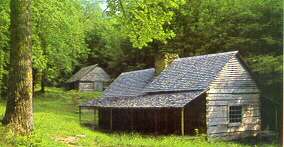Echoes From The Past
By JUDY MAUPIN
*- Echoes From the Past
(A Column of historical and genealogical anecdotes, stories and family notes.)
Calloway County, Ky.
James Thomas Journey to Kentucky
January 13, 1979 -
Today we are continuing with Edison Thomas' account of the journey of :James Thomas from North Carolina to : Kentucky.
"When James Thomas reached Fort Patrick Henry, near what is now Kingsport, Tenn., he was faced with a choice of two routes, either of which would likely be difficult. One was to travel down the Holston River on a flatboat. Even before 1780 pioneers
. were floating down the Holston into Tennessee en route on their long journey to what was to become known as the Cumberland settlements, now Nashville. This worked especially well in the spring, although John Donelson had left Fort Patrick Henry in December 1779 for Fort Nashboro, traveling all the way down the Tennessee River to its confluence with the Ohio near what is now Paducah, then up the Ohio to the Cumberland then up that stream to the site of present day Nashville, a journey of over 800 miles and one that required more than four months to make.
(NOTE: see the earlier column which accounted John Donelson's early exploration of Western Kentucky.)
The other choice for James Thomas
owas to continue his overland journey, one that led down the valley toward Knoxville over a well established trail on the west side of the Holston River.
During the dry summer months when the Hoiston was short on water, many
o emigrants took that still perilous overland route that led from Elizabethtown via Rogersville to Kingston, Tenn., west of Knoxville. This trail was extremely dangerous as late as 1784. Lone riders hired to carry letters from Elizabethtown and Watauga via Kingston to Fort Nashboro, charged as much as $50 to make the trip, a sum "dearly earned in many cases," it was said.
By 1806, however, the danger was minimal, especially from Indian attack. By that year too, the renowned Cumberland Gap route was seldom used as an entry for emigrant- headed for Kentucky. The Gap continued to be used as a thoroughfare by those traveling to and from the state, but most choice lands of Kentucky's famed Bluegrass region had been claimed by the late 1700's so settlers continued farther west. In addition, for those heading for the extreme western part of Kentucky, the Gap route would have added many miles to their journey.
Actually, it is not known for sure whether James Thomas rode down the Holston by. flatboat or continued by land. It is generally believed, however, that he chose the flatboat because April was the ideal time for such a venture, and James Thomas was not one to let a good opportunity pass without attempting to take advantage of it. Spring rains and melting snows from high in the Appalachians usually kept the Hoiston and its tributaries well supplied with water sufficient for the floating of flatboats until early summer.
Assuming that the Holston route was James' choice, his need was for a flatboat. Fact was, he needed two, for he intended to take his entire worldly possessions aboard. These possessions consisted of two wagons loaded with household goods, two yoke of oxen, one milk cow, probably two horses, most certainly a dog, a couple of cats, several chickens, maybe a hog or two -and of course - his wife, six children and likely one or two Negro slaves.
Except for stops at night when they landed and made camp, and a few daytime stops in order to replenish the food supply by shooting wild game, the trip was probably rather uneventful. The Holston and French Broad rivers join near Knoxville to form the Tennessee River, but that was just another overnight stop for those settlers making the river journey. They floated some additional 50 miles to Kingston at the confluence with the Clinch River. There the emigrants debarked and disposed of their flatboats.
Settlers who had sold their oxen and wagons before leaving on their trip down the Holston had to trade for more at Kingston before heading west across the Tennessee highlands. This was one problem that James Thomas didn't have to face.
Kingston, Tennessee, was located at the end of a long, grassy valley. Across the river from the settlement was Southwest Point, a military garrison so stationed to protect settlers headed west over the Walton Road.
Next week, we will follow the Thomas family on the last leg of their trip to their new home on Donelson Creek.
I have had an inquiry about a family who lived around Hopkinsville and Christian County in the 1800's from Mrs. Ernest Madrey. The names are Tom and David Scarbrough. If any reader can help with information about these men, contact either me or Mrs. Madrey.

